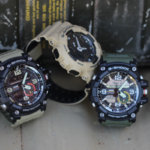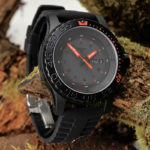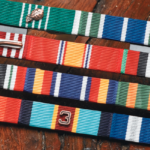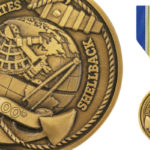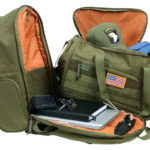This is part 2 in our series on the display of appurtenances. If you missed part 1 you can read it here.
C. Differences in Device Usage
As for case C, the following are examples of conflicting directives in the use of devices:
1. For a good number of years, an additional award of the National Defense Service Medal was denoted by an oak leaf cluster on the Army version and a small (3/16″) bronze star by all the other Services. The small bronze star is now used universally.
2. The Army and Air Force use the bronze arrowhead device on the ribbons of the World War II and Korean campaigns and, in the case of the Army, the Vietnam, Afghanistan and Iraq Campaign ribbons and the Armed Forces Expeditionary Medal (for the Grenada and Panama Operations). Although active participation in assault landings is part of the Navy’s mission, they have never authorized the wear of this device.
3. The Navy and Marine Corps use the small (3/16″) bronze star on their unit awards, i.e., Unit Commendation, Meritorious Unit Commendation and Presidential Unit Citation, as an additional award device. The Coast Guard, however, uses the large (5/16″) gold star on its equivalent unit awards.
4. Until the Department of Defense standardized the practice, most of the Services used a system of bronze numerals to indicate additional awards of the Humanitarian Service Medal. From the outset, however, the Coast Guard used small (3/16″) bronze and silver stars to denote one and five additional awards of the medal respectively. It is the Coast Guard system that is now in effect for all Branches of the Service (page 141).
5. Contrary to other policies covering personal and unit awards, no provisions are made to denote the fifth and subsequent awards of the Navy “E” Ribbon. Upon receipt of the fourth award, the wreathed silver “E” is worn and no further devices may be affixed to the ribbon thereafter.
6. The Coast Guard has only recently permitted the wear of the oak leaf cluster on its uniform. Anyone earning an additional award of a Joint Service decoration (e.g., DDSM, DSSM, DMSM, etc.) or any award(s) earned while part of the Army or Air Force is no longer required to substitute the large (5/16″) gold star for the now universal oak leaf cluster.
7. The Army permits the wear of devices on the Republic of Vietnam Gallantry Cross Unit Citation (bronze palms plus gold, silver and/or bronze stars) to denote the level of the award as well as subsequent awards. The other Services only allow the display of a single bronze palm.
D.The Multiplicity of Device Types
Case D arises from the fact that many different devices can be worn on the same ribbon. Although two might be acceptable, e.g., letter “V” with gold star, arrowhead with battle star, etc., things are definitely out of hand when as many as three distinct device types can be affixed to the same ribbon. The most extreme examples in the ribbon clutter category are the following:
1. The Navy, which permits the wear of the Presidential Unit Citation with a gold letter “N”, a gold globe and a bronze star at the same time.
2. The Coast Guard, which authorizes the simultaneous display of a bronze letter “V”, (5/16″) gold/silver stars and a silver letter “O” on the ribbons of its Commendation and Achievement Medals.
3. The Navy and Marine Corps, which use gold numerals, plus bronze numerals and the bronze letter “V” simultaneously on the Air Medal.
4. The Department of Defense, which now prescribes the hourglass (gold, silver & bronze) as well as a bronze letter “M” and bronze numeral on the Armed Forces Reserve Medal.
